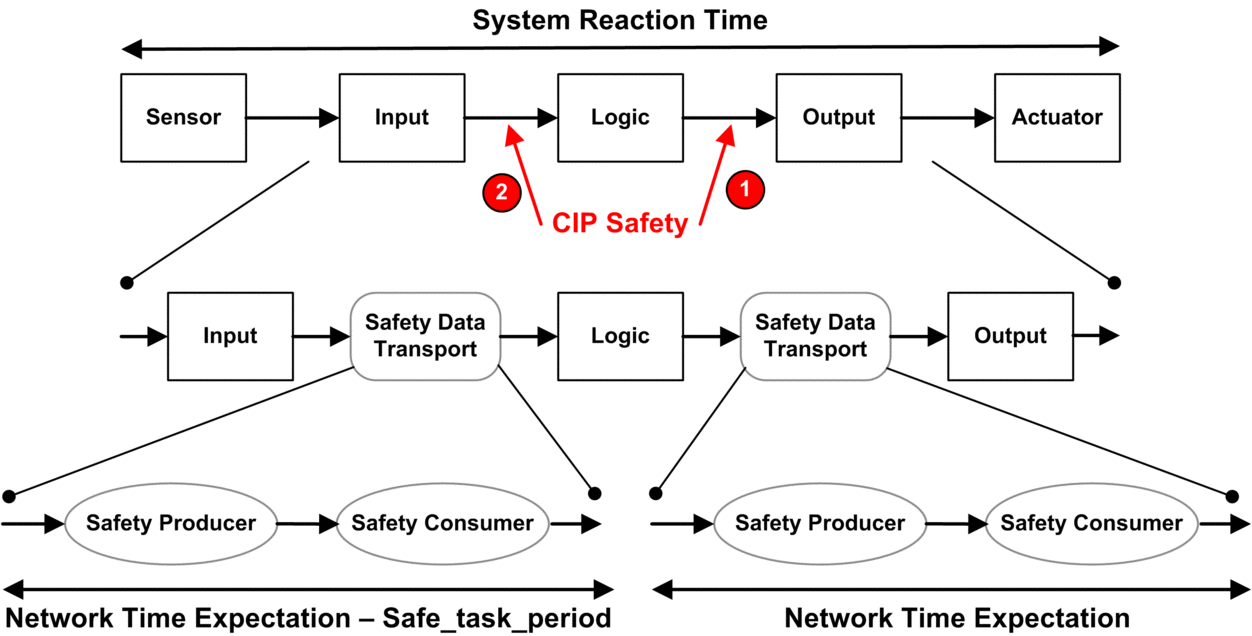Introduction
Time consumed by CIP safety communication, called the network time expectation, is added to and becomes part of the system reaction time. The network time expectation represents the maximum, or worst case, time period starting when the data is captured by the safety data producer, and ending when the consuming application recognizes a safety state. This also includes errors during production and consumption.
If the CIP Safety communication is between an input and the logic, replace the term variable TCOMM_IN in the process safety time calculation with Network Time Expectation - Safe_task_period. If the CIP Safety communication is between the logic and an output, replace the variable TCOMM_OUT in the process safety time calculation with Network Time Expectation.
Default measures of the Network Time Expectation vary, depending on the role of the M580 safety CPU as producer or consumer.
The elements of network time expectation, and its placement within the context of system reaction time, is set forth in the following diagram:

1 CIP Safety CPU as producer
2 CIP Safety CPU as consumer
Calculating Network Time Expectation
The Network Time Expectation can be calculated using the following formula:
Network Time Expectation = Network_Time_Expectation_Multiplier * 128 μSec > (EPI * Timeout_Multiplier + Safety_Message_Time(max) + Time_Coord_Message_Time(max) + Connection_Correction_Constant*128 μSec)
Where:
Safety_Message_Time(max) is the actual time from the data being captured by the safety data producer until the time that the safety data is passed to the consuming application for use.
Time_Coord_Message_Time(max) is the maximum time it could take for the time coordination information to be sent from the consumer to the producer.
Timeout_Multiplier is a parameter used in CIP safety protocol processing, which determines the number of messages that may be lost before declaring a connection error. A Timeout_Multiplier of 1 indicates that no messages may be lost.
Connection_Correction_Constant is a value in 128 μSec increments that is subtracted from the time stamp to represent the worst case error due to time drift, the asynchronous nature of the producer and consumer clocks, and the minimum time for the Time Coordination Message to traverse from the consumer to the producer.
EPI is the expected packet interval, and is based on the configured SAFE task period.
Network_Time_Expectation_Multiplier and Timeout_Multiplier are CIP communication parameters configured for the SafetyOpen Type 2 connection frame.
Default Network Time Expectation Values
The default calculation for the network time expectation value depends on the role of the CIP Safety CPU as consumer (case 2 in the preceding diagram) or producer (case 1).
CPU as consumer (case 2):
Timeout_Multiplier = 2
EPI = SAFE task period / 2
Safety_Message_Time(max) = Safe task period + 20 ms (worst case)
Time_Coord_Message_Time(max) = Safe task period + 20 ms (worst case)
Connection_Correction_Constant = 0 ms
Network Time Expectation = 1.5 * minimum_Network_Time_Expectation = 1.5 * (3 * Safe task period + 40 ms) = 4.5 * Safe task period + 60 ms
CPU as producer (case 1):
Timeout_Multiplier = 2
EPI = SAFE task period
Safety_Message_Time(max) = Safe task period + 20 ms (worst case)
Time_Coord_Message_Time(max) = Safe task period + 20 ms (worst case)
Connection_Correction_Constant = 0 ms
Network Time Expectation = 1.5 * minimum_Network_Time_Expectation = 1.5 * (4 * Safe task period + 40 ms) = 6 * Safe task period + 60 ms


